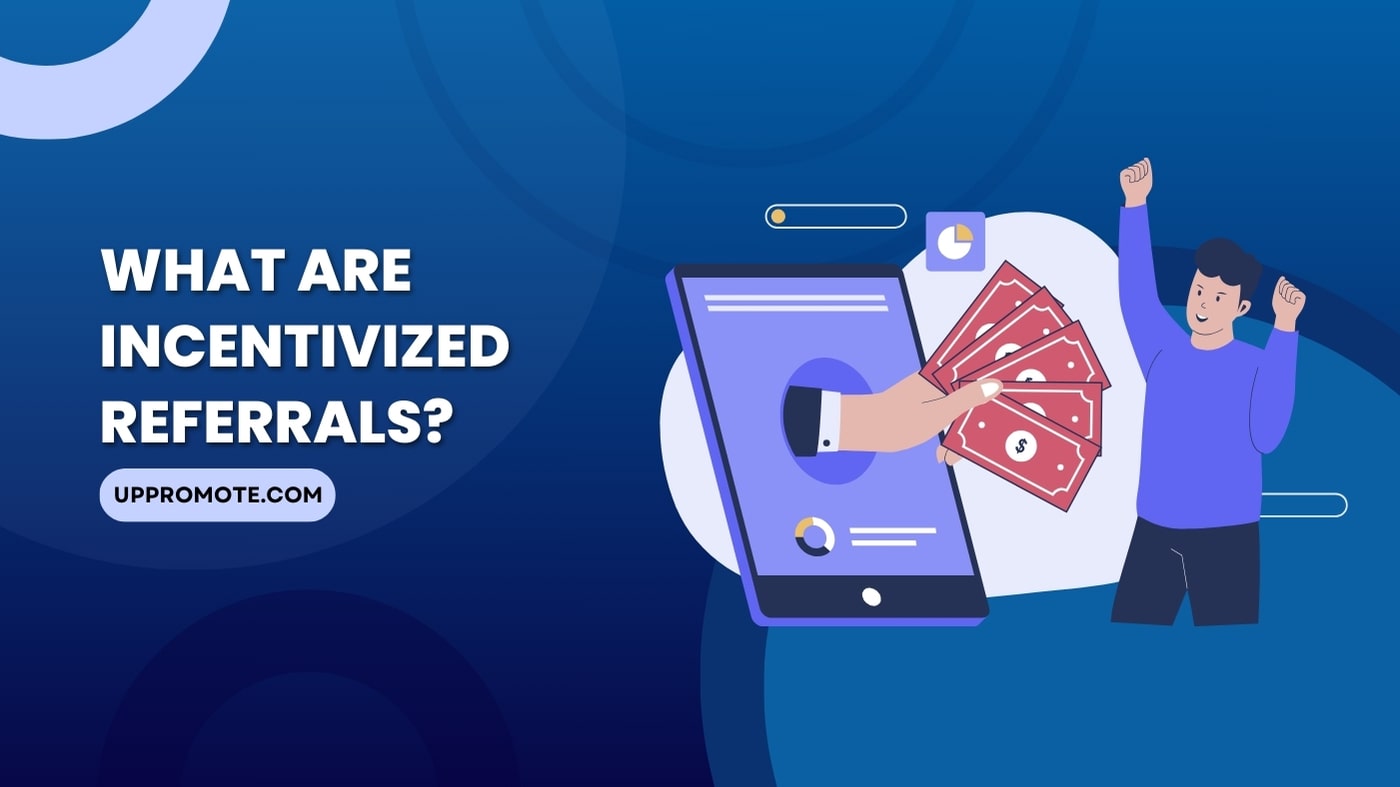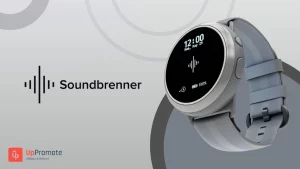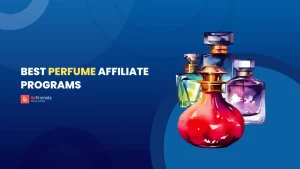Have you ever heard of incentivized referrals? They’re a clever way to encourage customers to spread the word about your business. However, choosing the right incentives and ways to measure successful referral incentives can be tricky.
Let’s dive in and explore some tips to help you pick the perfect rewards for your referral program.
What are Incentivized Referrals?
First, you need to understand what a referral is.
A referral is when someone recommends a company’s products or services to their friends, family, or colleagues.
Both the person making the referral (the referrer) and the person being referred to (the referee) receive rewards or incentives, which is called a “double-sided” reward and is usually very effective.
A referral reward is like a thank-you gift for customers who tell their friends about a company. These rewards can be discounts, free stuff, or even cash. They’re part of a referral program where companies ask customers to spread the word about their business.
When choosing rewards, it’s important to pick something that customers will like but won’t cost the company too much. We’ll explore all the options and steps to help you start your referral program.
Benefits of Incentivized Referrals
Incentives have a big impact on how people act. Regarding referrals, the right incentives can motivate customers to spread the word about your business.
With a tempting referral reward, you can encourage more of your customers to become brand advocates and share their positive experiences with others.
Referral marketing isn’t just about growing your business—it’s also about nurturing relationships with your customers.
Let’s find out some of its outstanding benefits:
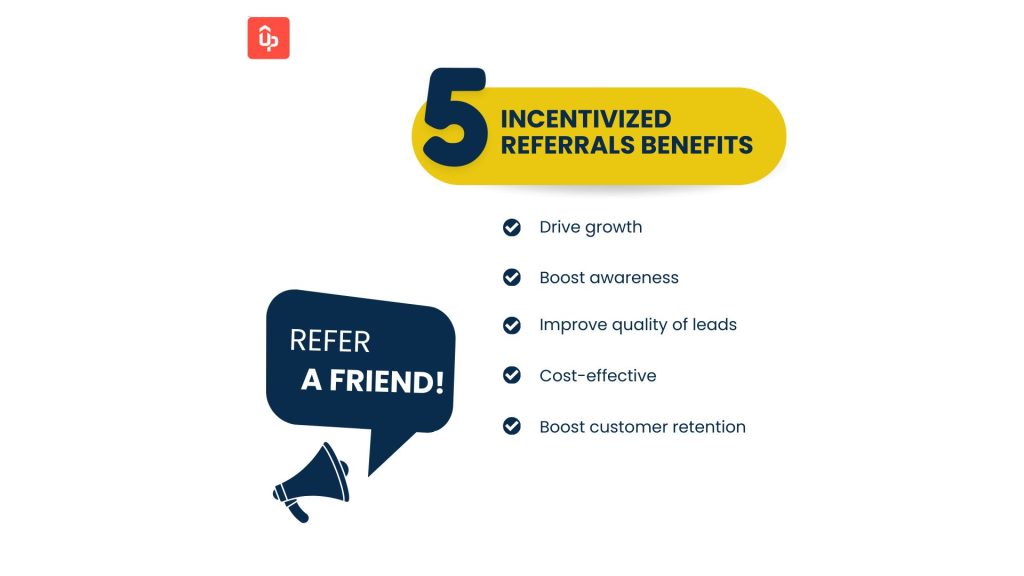
Drive Growth
Getting customers to recommend your business to their friends and family can be a great way to grow. Offering rewards or incentives for referrals is a smart move. Your current happy customers likely know tons of people.
If you give them a reason to talk you up, they can help you land many new customers. This can allow your business to grow faster than just relying on advertising or other ways to find new customers.
Boost Awareness
Customer referral programs also help more people learn about a brand. When customers share how much they like a product or service with others, they’re basically giving the brand a shout-out.
This word-of-mouth marketing introduces the brand to new folks who might not have heard about it otherwise. This extra attention helps the brand become more recognizable and builds a good reputation in the market.
Improve Quality of Leads
People referred by existing customers are more likely to buy from you than other leads. That’s because your customers only refer people they think are a good fit.
Also, a referral makes the new potential customer trust you more upfront. So, you end up with leads with a higher chance of becoming paying customers.
Boost Customer Retention
An incentive program shows your customers you value them. It gives them a reason to stay engaged with your business and keep referring people. This can improve customer loyalty and retention over time.
Cost-Effective
Incentivized referral marketing programs provide a cost-effective method for acquiring new customers.
Referral programs often require lower upfront investment while yielding high-quality leads than traditional advertising channels, such as paid ads or sponsored content.
Since referrals come from satisfied customers, they tend to have a higher conversion rate, thereby reducing customer acquisition costs.
Tips to Choose the Right Referral Incentives
With countless business types come countless referral rewards and incentives. Unsure whether a percentage discount or cash payout would entice more customers?
When setting up your referral rewards program, start by identifying who you want to motivate. You can consider who will bring the most benefit to your business. This decision shapes the foundation of your referral campaign.
Once you know your target, planning the incentive, program structure, and messaging becomes more straightforward.
Understand the types of Referral Incentives
Referral rewards usually fall into three types of rewards:
- one-sided,
- two-sided (also known as double-sided or dual-sided),
- and no incentive (we don’t recommend it!).
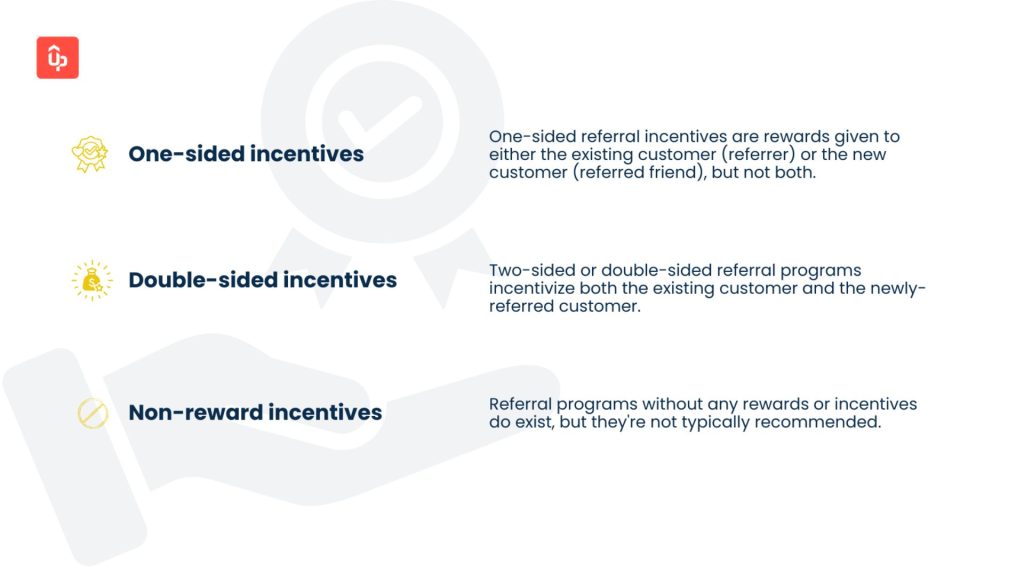
One-sided referral incentives
One-sided referral incentives are rewards given to either the existing customer (referrer) or the new customer (referred friend), but not both.
One-sided incentives for existing customers (the referrer)
Pros:
- Encourage existing customers to refer others, boosting brand awareness and generating new leads.
- Foster stronger relationships, improve customer retention, and increase brand loyalty.
- Ideal for new companies looking to grow their brand and those offering affordable products.
Cons:
- Referrals may seem less authentic when only existing customers receive compensation.
- The referred friend may not be as motivated to make a purchase without an incentive.
Best for:
- New companies aiming to increase brand awareness.
- Businesses selling affordable products as one-sided rewards encourage customers to refer others.
One-sided incentives for the new customer (the referred friend)
Pros:
- Highly effective in converting prospects into customers through discounts or freebies.
- Increase the likelihood of referred parties engaging with your business, moving them down the sales funnel.
Cons:
- Without a reward, existing customers may not actively refer others, even if they love your brand.
- May lead to a smaller number of referrals compared to two-sided incentives, but can still expand your customer base.
Best for:
Businesses using subscription models, frequent purchases, or luxury products. One-sided incentives can help convert interested parties into long-term customers and expand your customer base.
Two-sided referral incentives
Two-sided or double-sided referral programs incentivize both the existing customer and the newly-referred customer. Rewards can be the same for both or different, such as credits or discounts.
Pros:
- Maximize successful referrals by motivating both parties to participate.
- Avoid making advocates seem self-serving by offering rewards to new customers as well.
Cons:
- Require resources to provide incentives to both parties.
- Tracking multiple incentives for both sides can be labor-intensive.
Best for:
Businesses with resources to provide rewards to both parties. It’s ideal to have a reliable referral software tool (like UpPromote) to track metrics effectively.
Non Rewards
Referral programs without any rewards or incentives do exist, but they’re not typically recommended. Some businesses opt to rely on creating a positive customer experience to encourage word-of-mouth referrals.
Pros:
- Some customers naturally enjoy sharing good experiences with their friends.
- Starting without incentives lets you measure initial sharing and conversion rates.
- Non-incentivized referrals are often seen as genuine recommendations.
Cons:
- Most customers need motivation to refer to others without incentives.
- Customers may not follow through on referrals without a tangible reward.
- Tracking referrals becomes more challenging without rewards.
Best for:
Companies with limited budgets or those aiming to establish a natural referral rate. Luxury or aspirational brands may also prefer non-incentivized programs to maintain a certain image.
Select the referral rewards to offer
Referral rewards are essential for driving engagement in your referral program, but there’s no one-size-fits-all approach. The right reward depends on your business type and customer base.
So what are some common referral rewards across various businesses:
- Discounts
- Cash/Cashback
- Store Credit
- Free Products
- Branded Swag
- Gift Cards
- Free Subscription Period:
- Donations
- Referral Gifts
One of the most common referral rewards is discounts. Offering discount coupons as rewards can incentivize customers to refer others to your business. Discounts are particularly effective in encouraging a better high-consideration purchase and fostering customer loyalty.
When choosing this reward, consider the percentage or dollar amount of the discount and ensure it aligns with your profit margins and overall pricing strategy.
Cash or cash incentive are also a great choice. Giving money as a reward can really catch people’s attention because they can use it however they want and right away.
This kind of reward can push people to tell others about your business, especially if what you’re selling is expensive or not often bought. But before you decide to give out cash rewards, make sure you think about how much it will cost you and if it fits with how much money you’re making.
CriticalPass sells study materials to help people pass law school exams. Once customers buy, they don’t need to buy again. So, CriticalPass gives $10 cash as a reward when someone refers a friend.
This works because even if you’re already in a senior or manager role, you can still tell your junior friends about it. And $10 is $10, which everyone can use.
Store credit is a reward option that allows customers to spend rewards on future purchases. This can encourage repeat business and build loyal customers.
When offering store credit as a referral reward, you should consider factors such as the redemption referral process and any restrictions or limitations on its use.
Seraphine, a store selling maternity clothes, gives you a 15% discount coupon when you refer a friend.
Branch Basics, a company selling cleaning products, gives you $10 off your next purchase when you refer a friend and they buy a refill.
A free subscription period can be an enticing reward for businesses operating on a subscription model. Offering customers a complimentary trial of your services can encourage them to refer others and generate interest in your offerings.
If you decide to provide free subscription periods as rewards, consider the duration and terms of the trial and ensure it provides value to both the customer and your business.
And donations offer customers the opportunity to contribute to charitable causes as part of your referral program.
By allowing them to support charitable causes, you foster a positive brand image and create a sense of goodwill among your customer community. Partner with reputable charities and transparently communicate the impact of their contributions to enhance engagement and trust.
Looking for more advice on choosing the best referral rewards? Here are some insider tips to help you out:
👌 Ask your customers directly what rewards they would like to receive. You can run a poll with a few options to better understand what truly motivates your clients.
👌 Take a look at your competitors’ referral rewards programs. This can give you insights into common patterns in your niche and industry, helping you make your program stand out.
👌 Make sure the referral reward you offer is truly valuable. If it’s something customers can easily get elsewhere or if it’s not relevant to their needs, they might not be motivated to participate.
👌 If you’re offering a reward to the new customer (the referred friend), ensure it’s directly related to your business. This can help motivate them to make their first purchase.
👌 Don’t hesitate to change up your incentives to increase engagement with your program. For example, you could increase the amount of store credits offered or add a free gift to the cash referral reward during slower business periods. Flexibility can help keep your program fresh and appealing to customers.
How to Measure the Success of Referral Incentives?
But why do you need data for your referral program to succeed?
Referral programs can hit a snag when they start growing a lot. When starting with a small program, it’s easy to keep track of who’s doing what and give out rewards.
But as your program gets bigger and more complicated, it gets harder to manage. Basic methods of tracking just won’t cut it anymore.
You need to be able to monitor what people are doing in real time and ensure they get their rewards on time. If you don’t have good systems in place for keeping track and giving out rewards, things can quickly get messy.
So, to make sure your referral program keeps growing smoothly, it’s crucial to always monitor how it’s performing and use data to make smart decisions.
Referral Rate
Participation Rate
This key metric shows how many people have joined your referral program and are willing to spread the word about your brand. It gives insight into the effectiveness of your promotional strategies and the visibility of your program.
Tracking the participation rate helps you assess if your marketing efforts are reaching the right audience.
For instance, a low participation rate might suggest that your promotion channels are not effectively targeting your desired audience. By analyzing this data, you can make informed decisions about adjusting your promotional activities or enhancing your program’s visibility on your website.
Share Rate
The share rate indicates how many advocates share referrals after joining your program and how frequently they do so through social media, email, or dedicated links. Understanding the preferred sharing channels can help optimize your promotional efforts.
Tracking the share rate provides insights into the effectiveness of your referral rewards and the ease of use of your sharing channels.
For example, a low share rate may indicate that your rewards are not compelling enough to motivate advocates to share or that your sharing channels are not user-friendly.
Conversion Rate
A conversion happens when new visitors on your website do something you want them to do, like signing up or making a purchase. The conversion rate is how many of these actions happen compared to everyone visiting your site.
Success rates are about more than just sales; they include things like getting people’s email addresses or having them sign up for newsletters. These are important because they help you find potential customers who are interested in your business.
To make your referral program work well, you need to figure out what actions you want people to take and then see which ones are working best and which ones need improvement.
The most important thing to watch is the purchase rate, which shows how many purchases were made compared to the number of times people shared your referral program. You can see how well your referral program is doing by tracking how much money comes in from referrals.
If some parts of your referral program, like sharing links or making purchases, aren’t happening as much as you’d like, you can make changes to improve them. This will help your referral program increase sales and be more successful overall.
Customer Acquisition Cost (CAC)
Customer acquisition cost, or CAC, tells you how much money it takes to get new customers from a specific campaign. It shows the cost of getting people to sign up.
You can make this metric better by:
- Check your data often and focus on the referral channels that bring in the most new customers for the least money.
- Moving money away from programs that don’t work as well so you can use it where it makes the most difference.
- Testing different approaches to see what works best, especially when getting new customers, is expensive.
Lifetime Value of Customers (LVC)
Customer lifetime value (CLV or LVC) is the total value a customer brings to your business over the entire duration of your relationship. Understanding CLV is crucial for evaluating the overall success of your referral campaign because it reveals the revenue generated by each advocate.
To calculate CLV, multiply the amount of revenue generated by a specific customer by the number of sales attributed to them.
Improving CLV involves incentivizing advocates to promote your business further. This could mean enhancing rewards or sending reminder emails highlighting your offerings and encouraging continued engagement.
Let’s say a customer referred three friends to your online store. Each friend made a purchase worth $50, resulting in a total of $150 in revenue attributed to that customer’s referrals. If the customer themselves also made purchases totaling $200, their total contribution to your business’s revenue would be $350.
To improve this customer’s lifetime value, you might offer them additional incentives, such as exclusive discounts on future purchases or bonus rewards for each successful referral. This encourages them to continue promoting your business, leading to more referrals and increased revenue over time.
Number of Repeat Referrers
The number of repeat referrers shows how many people are referring their friends to your business multiple times. It’s like when you have a friend who keeps telling other people how great a restaurant is and brings different friends there each time.
You can measure this by tracking how often the same person refers to someone new.
For example, if Sarah tells her friend about your store and then tells another friend a few weeks later, that’s two referrals from one person.
Knowing how many repeat referrers you have can help you understand how loyal your customers are and how much they believe in your business. It shows they’re happy with what you offer and want to share it with others repeatedly.
This metric is important because it tells you how effectively your referral program turns customers into advocates who keep spreading the word about your business.
3 Examples of Incentivized Referrals
PayPal
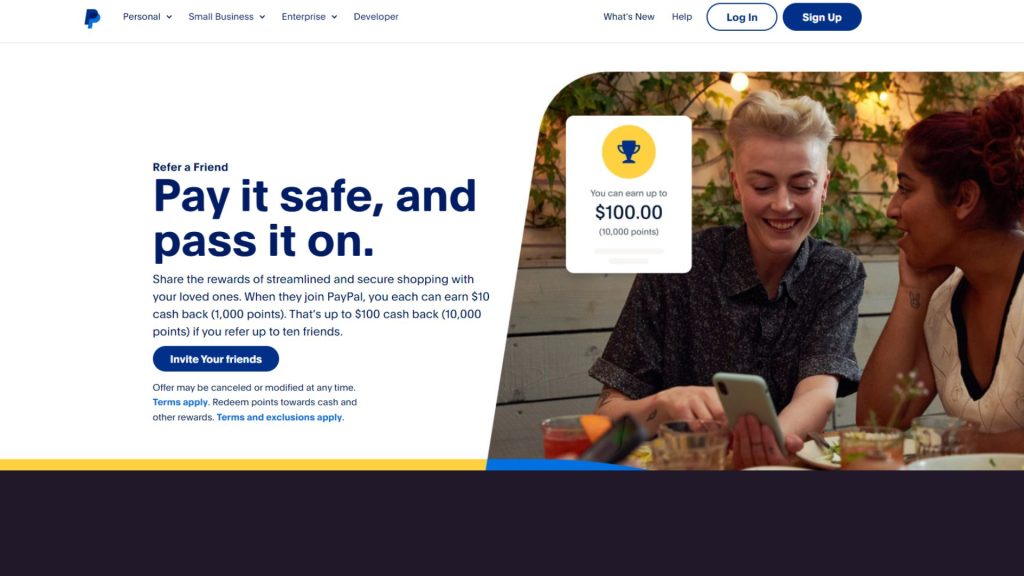
PayPal led the way in referral programs, being one of the first to reward users for referring friends, setting a trend for similar programs to follow.
Its referral program offers “two-sided rewards” for customers and their friends.
Referrer incentives:
- Users can earn up to $100 cashback (10,000 points) by inviting up to ten friends.
- Both the referrer and the friend they refer earn 1,000 points (equal to $10 cash back) when the friend signs up and spends at least $5 within 30 days.
- The maximum reward for the referrer is 10,000 points per calendar year.
Referee incentives:
The friend who signs up (referee) also earns 1,000 points ($10 cash back) when they spend at least $5 within 30 days of signing up.
The New York Times
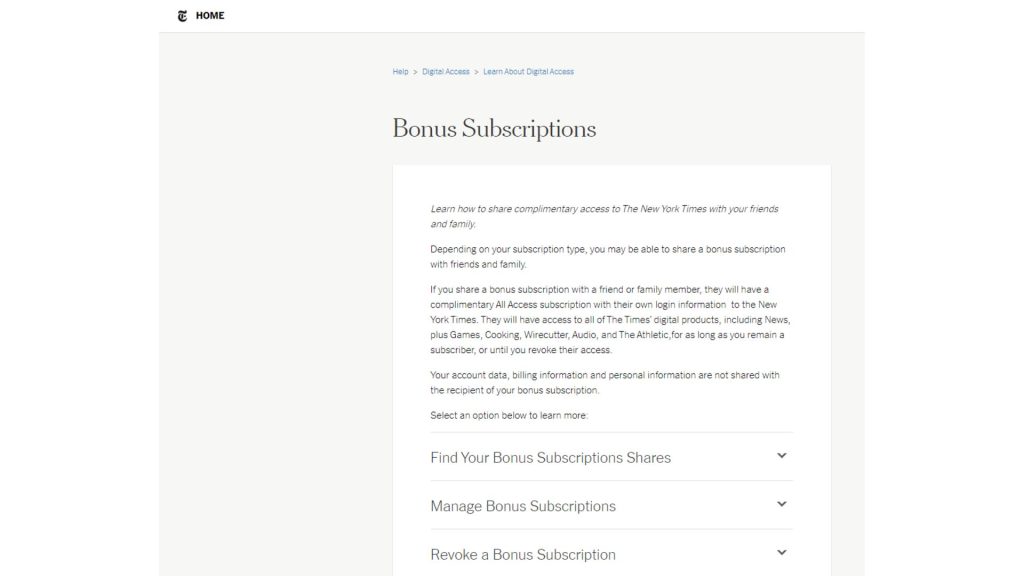
The New York Times, renowned for its journalism, has a referral program aimed at encouraging current customers or subscribers to spread the word about the newspaper. It offers various rewards to incentivize sharing.
Subscribers can take part in the Sponsor a Student Subscription Program. Five public school students receive a free subscription for each purchase made through a subscriber’s referral link. Additionally, those invited through the referral link can sign up for a discounted subscription at $1 per week.
Referrer Rewards:
- Invite friends and family via email to join The New York Times at a special rate of $1 per week for the first year.
- After the first year, the regular rate of $4.25 per week will apply.
Robinhood
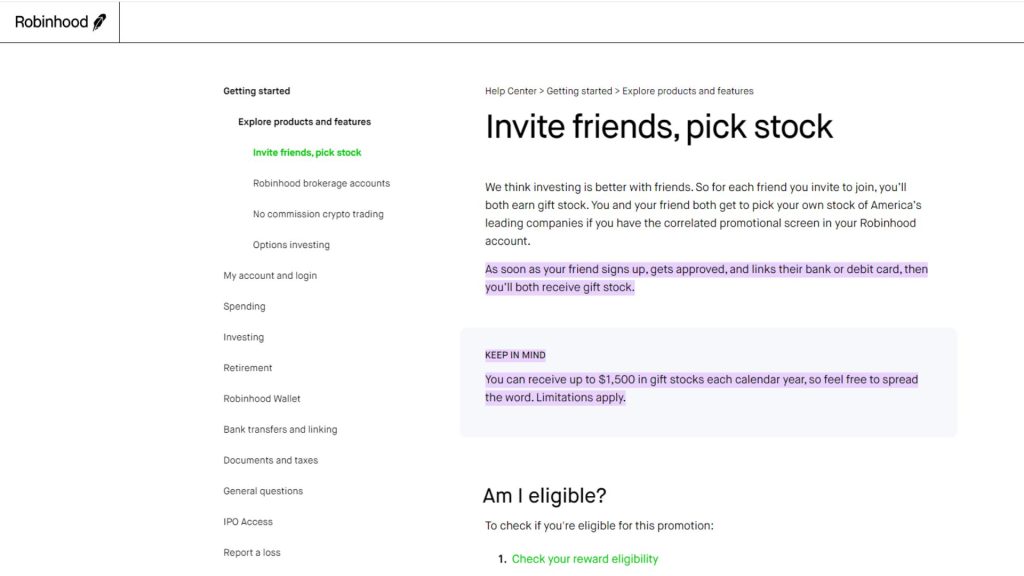
Robinhood Markets is a well-known financial services company that shook up the industry by introducing commission-free stock and ETF trades through its mobile app. It’s also planning to offer commission-free cryptocurrency trading, which has attracted over 1.2 million customers daily.
Currently, Robinhood supports trading in cryptocurrencies like Bitcoin, Ethereum, Dogecoin, and Litecoin. With plans to fully support cryptocurrency wallets for deposits and withdrawals, the company, now public after its IPO on Nasdaq, boasts over 31 million customers.
The referral program is a key part of Robinhood’s referral marketing strategy for acquiring customers, offering cost-effective benefits compared to other marketing methods.
Referrer Rewards:
When you refer a friend, you can receive a stock valued between $5 and $200.
Referee Rewards:
Similarly, the friend you refer to also gets a stock selected from a group, with its value ranging from $5 to $200.
FAQs
- Can incentivized referrals really benefit my business?
Yes, incentivized referrals can greatly benefit your business. They motivate existing customers to refer to new ones, leading to increased customer acquisition, higher sales, and improved brand loyalty. Additionally, incentives can help create positive word-of-mouth marketing and expand your customer base.
- How to choose the best referral incentive type for my business?
To choose the best referral incentive, consider your business type and customer preferences. Analyze common rewards like discounts, cash, or free products. Conduct customer surveys and study competitors’ programs. Ensure the custom reward is valuable, aligns with your brand, and motivates action. Test and adjust as needed for optimal results.
- How to promote my referral incentives to my existing customers?
Promote referral incentives to existing customers through multiple channels. Use email newsletters, social media, website banners, and in-app notifications. Highlight the benefits, share success stories, and make it easy to participate. Encourage sharing through personalized messages and exclusive offers.
- What makes successful referral programs?
Successful referral programs offer valuable rewards, easy sharing options, and clear instructions. They align with the brand’s values, encourage participation, and track metrics for optimization. Effective communication, seamless user experience, and timely rewards contribute to their success.
- Can you ask for referrals for free?
Yes, you can ask for referrals without offering monetary incentives. Strategies like providing exceptional service, creating a positive customer experience, and building strong relationships can naturally encourage customers to refer others to your business at no cost.
Conclusion
To boost your referral marketing campaign, choose rewards tailored to your customers’ buying habits. For infrequent purchases, opt for cash, gift cards, or swag. For repeat purchases, offer discounts, store credit, or free upgrades. Tailoring an attractive reward ensures a successful and engaging program for your customers.
By following the steps outlined in this article, you can identify the most suitable referral rewards and incentives for your business. This approach will help you create a referral program that sustains customer interest and motivation over the long term, driving ongoing success for your business.


